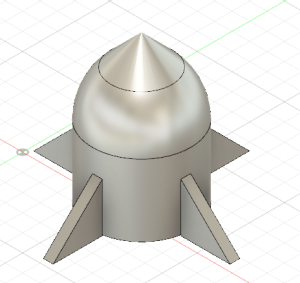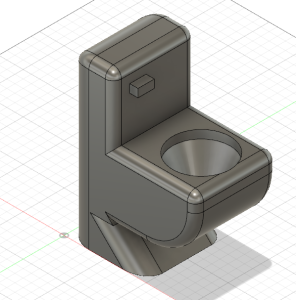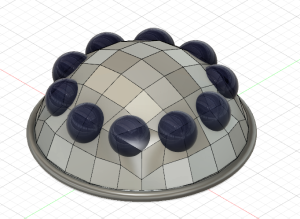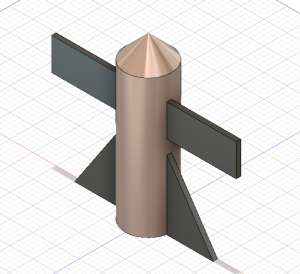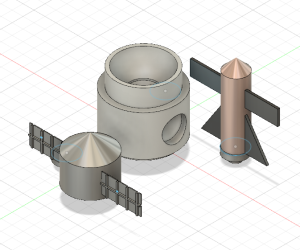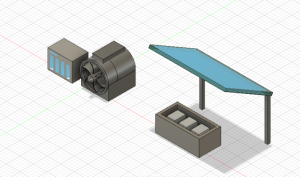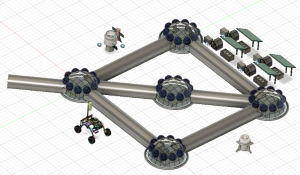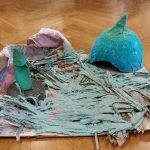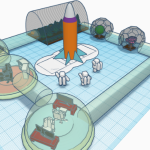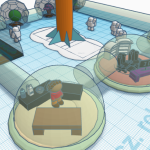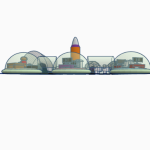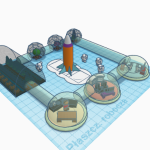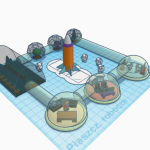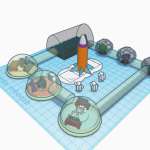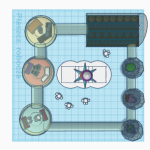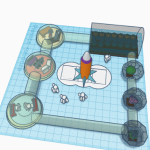Más allá de las estrellas, buscando un nuevo Hogar by Campamento Lunar_9C
FUNDACIÓN COLEGIO CARDENAL JOHN HENRY NEWMAN Cajica-Cundinamarca Colombia 15 years old 25 / 14 Spanish Moon
External Viewer for 3D Project
Project description
Un grupo de estudiantes de grado noveno del colegio Newman School, integraron diversas disciplinas (Matemáticas, física y tecnología) para diseñar en tercera dimensión un campamento lunar innovador que pudiera servir como hogar y centro de trabajo para las futuras generaciones que habitarán la Luna. El equipo, compuesto por 23 estudiantes, donde cada uno asumió un rol especifico dentro de la construcción del modelo, lograron diseñar un habita seguro, con todas las condiciones necesarias para vivir. El Campamento Lunar puede tener el propósito de hacer investigaciones científicas y exploración en la Luna. El objetivo es tener más conocimiento sobre la Luna, su formación, su historia geológica y su potencial para futuras misiones espaciales. También se puede construir con el fin de explorar y aprovechar los recursos lunares con fines comerciales, el objetivo sería desarrollar una industria sostenible en la Luna que pueda respaldar las actividades humanas a largo plazo. Finalmente también podría ser construido con el objetivo de fomentar el turismo espacial y ofrecer experiencias únicas a los visitantes. El Mar de la Tranquilidad es un cráter lunar con un diámetro aproximado de 880 kilómetros y un área de 371,000 kilómetros cuadrados, este cráter puede ser ideal ya que no tiene paredes altas en comparación con otros cráteres, este fue el cráter donde Apolo 11 alunizó y sera usado para el campamento. El campamento lunar proporciona las necesidades de alimentación para los astronautas.Agua: el proceso de eliminación de hielo de la superficie lunar o el reciclaje y limpieza de aguas residuales. Las tecnologías para conservar el agua también podrían usarse para reducir el desperdicio. Alimentos: Los astronautas pueden obtener alimentos frescos y saludables cultivando una huerta lunar. Esto podría incluir cultivos cultivados hidropónicamente o con métodos agrícolas controlados en un suelo modelado como el de la luna. Además, se podrían conservar alimentos no perecederos y se podrían investigar alternativas a los alimentos liofilizados y deshidratados para mejorar la diversidad y la longevidad. Aire: Es fundamental disponer de un sistema de soporte vital que regenere el aire. Esto implica tanto la producción de oxígeno mediante la electrolisis del agua o la fotosíntesis de las plantas del jardín, como la recogida y purificación del dióxido de carbono exhalado por los astronautas.Energía: La energía se generará a través de paneles solares, que son una fuente abundante de energía en la Luna debido a la larga duración de los días lunares. Se van a usar baterías para almacenar la energía solar, y cables resistentes para que se pueda transferir por todo el campamento.
En nuestra estrategia de gestión de residuos en la Luna, implementamos un proceso meticuloso que separa los desechos sólidos de los líquidos. Los sólidos son enviados en un cohete no tripulado diseñado para desintegrarse al ingresar a la atmósfera lunar, mientras que la orina se procesa en una unidad especializada para convertirla en agua utilizable. Este enfoque garantiza una gestión eficiente de los recursos y minimiza el impacto ambiental en nuestro hábitat lunar, contribuyendo así a la sostenibilidad de nuestras operaciones. Al priorizar la gestión responsable de nuestros residuos, no solo preservamos el entorno lunar y optimizamos el uso de recursos, sino que también sentamos las bases para un desarrollo espacial sostenible y ético. Este enfoque integral demuestra nuestro compromiso con la exploración espacial responsable y la preservación del entorno natural en el espacio exterior. El principal vehículo sera un rover de exploración autónoma que identificara los alrededores tomando muestras para analizarlas en el laboratorio asignado. Este rover tendrá un brazo robotico con una cámara capaz de identificar las diferentes muestras que se están buscando. El brazo, por otro lado, recogerá las diferentes muestras y ayudara a los astronautas en tareas que necesiten de su ayuda. Sera manejado por bluetooth largo alcance y podrá ser controlado desde la base, sin necesidad de salir al exterior. Para evitar que se quede atascado, tiene una suspensión independiente que se ajusta a los cambios de elevación. El poder es proporcionado por cuatro motores de 12V, uno en cada llanta, lo cual permite una cantidad de poder equilibrada en todos los puntos de apoyo del rover. Para viajar de y hacía la tierra, tenemos un cohete con 4 separadores. Los dos primeros son para el viaje de ida, y los otros dos para el de vuelta. Cuando el cohete regrese, quedara la parte de la cabina.
Project link
https://docs.google.com/document/d/13WWLlL2yUALGSmmzEi42pyxVsuRnB1eD-tXryaa-EnE/edit?usp=sharing
English translation
A group of ninth grade students from the Newman School integrated various disciplines (Mathematics, physics and technology) to design in three dimensions an innovative lunar camp that could serve as a home and work center for future generations that will inhabit the Moon. The team, made up of 23 students, where each one assumed a specific role within the construction of the model, managed to design a safe habitation, with all the necessary conditions to live. The Moon Camp may have the purpose of doing scientific research and exploration on the Moon. The goal is to have more knowledge about the Moon, its formation, its geological history and its potential for future space missions. It can also be built in order to explore and harness lunar resources for commercial purposes, the goal would be to develop a sustainable industry on the Moon that can support human activities in the long term. Finally, it could also be built with the aim of promoting space tourism and offering unique experiences to visitors. The Sea of Tranquility is a lunar crater with an approximate diameter of 880 kilometers and an area of 371,000 square kilometers. This crater may be ideal since it does not have high walls compared to other craters. This was the crater where Apollo 11 landed and It will be used for the camp.The lunar camp provides the food needs for the astronauts.Water: The process of removing ice from the lunar surface or recycling and cleaning wastewater. Technologies to conserve water could also be used to reduce waste. Food: Astronauts can obtain fresh and healthy food by growing a lunar garden. This could include crops grown hydroponically or with controlled agricultural methods in soil modeled like that of the moon. Additionally, non-perishable foods could be preserved and alternatives to freeze-dried and dehydrated foods could be investigated to improve diversity and longevity. Air: It is essential to have a life support system that regenerates air. This involves both the production of oxygen through the electrolysis of water or the photosynthesis of garden plants, as well as the collection and purification of carbon dioxide exhaled by the astronauts. Energy: Energy will be generated through solar panels, which are a abundant source of energy on the Moon due to the long duration of lunar days. Batteries will be used to store solar energy, and strong cables so it can be transferred throughout the camp.
In our waste management strategy on the Moon, we implement a meticulous process that separates solid waste from liquid waste. The solids are sent on an unmanned rocket designed to disintegrate upon entering the lunar atmosphere, while the urine is processed in a specialized unit to convert it into usable water. This approach ensures efficient resource management and minimizes the environmental impact on our lunar habitat, thus contributing to the sustainability of our operations. By prioritizing the responsible management of our waste, we not only preserve the lunar environment and optimize resource use, but also lay the foundation for sustainable and ethical space development. This comprehensive approach demonstrates our commitment to responsible space exploration and the preservation of the natural environment in outer space. The main vehicle will be an autonomous exploration rover that will identify the surroundings by taking samples to analyze them in the assigned laboratory. This rover will have a robotic arm with a camera capable of identifying the different samples that are being searched. The arm, on the other hand, will collect the different samples and help the astronauts in tasks that need their help. It will be managed by long-range Bluetooth and can be controlled from the base, without having to go outside. To prevent getting stuck, it has an independent suspension that adjusts to elevation changes. Power is provided by four 12V motors, one in each wheel, allowing for a balanced amount of power at all points of support on the rover. To travel to and from Earth, we have a rocket with 4 separators. The first two are for the outward trip, and the other two for the return trip. When the rocket returns, the cabin part will remain.
#3D Design
Other Projects




